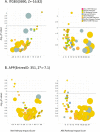Pathway-based analysis of genome-wide siRNA screens reveals the regulatory landscape of APP processing
- PMID: 25723573
- PMCID: PMC4344212
- DOI: 10.1371/journal.pone.0115369
Pathway-based analysis of genome-wide siRNA screens reveals the regulatory landscape of APP processing
Erratum in
-
Correction: Pathway-Based Analysis of Genome-Wide siRNA Screens Reveals the Regulatory Landscape of App Processing.PLoS One. 2015 Jun 1;10(6):e0129641. doi: 10.1371/journal.pone.0129641. eCollection 2015. PLoS One. 2015. PMID: 26030410 Free PMC article. No abstract available.
Abstract
The progressive aggregation of Amyloid-β (Aβ) in the brain is a major trait of Alzheimer's Disease (AD). Aβ is produced as a result of proteolytic processing of the β-amyloid precursor protein (APP). Processing of APP is mediated by multiple enzymes, resulting in the production of distinct peptide products: the non-amyloidogenic peptide sAPPα and the amyloidogenic peptides sAPPβ, Aβ40, and Aβ42. Using a pathway-based approach, we analyzed a large-scale siRNA screen that measured the production of different APP proteolytic products. Our analysis identified many of the biological processes/pathways that are known to regulate APP processing and have been implicated in AD pathogenesis, as well as revealing novel regulatory mechanisms. Furthermore, we also demonstrate that some of these processes differentially regulate APP processing, with some mechanisms favouring production of certain peptide species over others. For example, synaptic transmission having a bias towards regulating Aβ40 production over Aβ42 as well as processes involved in insulin and pancreatic biology having a bias for sAPPβ production over sAPPα. In addition, some of the pathways identified as regulators of APP processing contain genes (CLU, BIN1, CR1, PICALM, TREM2, SORL1, MEF2C, DSG2, EPH1A) recently implicated with AD through genome wide association studies (GWAS) and associated meta-analysis. In addition, we provide supporting evidence and a deeper mechanistic understanding of the role of diabetes in AD. The identification of these processes/pathways, their differential impact on APP processing, and their relationships to each other, provide a comprehensive systems biology view of the "regulatory landscape" of APP.
Conflict of interest statement
Figures





Similar articles
-
Amyloid precursor protein glycosylation is altered in the brain of patients with Alzheimer's disease.Alzheimers Res Ther. 2020 Aug 12;12(1):96. doi: 10.1186/s13195-020-00664-9. Alzheimers Res Ther. 2020. PMID: 32787955 Free PMC article.
-
Alzheimer's disease.Subcell Biochem. 2012;65:329-52. doi: 10.1007/978-94-007-5416-4_14. Subcell Biochem. 2012. PMID: 23225010 Review.
-
Presenilin 1 regulates the processing of beta-amyloid precursor protein C-terminal fragments and the generation of amyloid beta-protein in endoplasmic reticulum and Golgi.Biochemistry. 1998 Nov 24;37(47):16465-71. doi: 10.1021/bi9816195. Biochemistry. 1998. PMID: 9843412
-
Decrease in brain soluble amyloid precursor protein β (sAPPβ) in Alzheimer's disease cortex.J Neurosci Res. 2011 Jun;89(6):822-32. doi: 10.1002/jnr.22618. Epub 2011 Mar 23. J Neurosci Res. 2011. PMID: 21433051
-
[The beta-amyloid cascade hypothesis: a sequence of events leading to neurodegeneration in Alzheimer's disease].Neurol Neurochir Pol. 2004 Sep-Oct;38(5):405-11. Neurol Neurochir Pol. 2004. PMID: 15565529 Review. Polish.
Cited by
-
Genome-wide, high-content siRNA screening identifies the Alzheimer's genetic risk factor FERMT2 as a major modulator of APP metabolism.Acta Neuropathol. 2017 Jun;133(6):955-966. doi: 10.1007/s00401-016-1652-z. Epub 2016 Dec 8. Acta Neuropathol. 2017. PMID: 27933404 Free PMC article.
-
Risk factor SORL1: from genetic association to functional validation in Alzheimer's disease.Acta Neuropathol. 2016 Nov;132(5):653-665. doi: 10.1007/s00401-016-1615-4. Epub 2016 Sep 16. Acta Neuropathol. 2016. PMID: 27638701 Free PMC article. Review.
-
TREM2 in Neurodegenerative Diseases.Mol Neurodegener. 2017 Aug 2;12(1):56. doi: 10.1186/s13024-017-0197-5. Mol Neurodegener. 2017. PMID: 28768545 Free PMC article. Review.
-
Correction: Pathway-Based Analysis of Genome-Wide siRNA Screens Reveals the Regulatory Landscape of App Processing.PLoS One. 2015 Jun 1;10(6):e0129641. doi: 10.1371/journal.pone.0129641. eCollection 2015. PLoS One. 2015. PMID: 26030410 Free PMC article. No abstract available.
-
Early Life Stress and Epigenetics in Late-onset Alzheimer's Dementia: A Systematic Review.Curr Genomics. 2018 Nov;19(7):522-602. doi: 10.2174/1389202919666171229145156. Curr Genomics. 2018. PMID: 30386171 Free PMC article. Review.
References
-
- Hardy J, Selkoe DJ (2002) The amyloid hypothesis of Alzheimer's disease: progress and problems on the road to therapeutics. Science 297: 353–356. - PubMed
-
- Wolfe MS (2002) Therapeutic strategies for Alzheimer's disease. Nat Rev Drug Discov 1: 859–866. - PubMed
-
- Beher D, Graham SL (2005) Protease inhibitors as potential disease-modifying therapeutics for Alzheimer's disease. Expert Opin Investig Drugs 14: 1385–1409. - PubMed
-
- Parks AL, Curtis D (2007) Presenilin diversifies its portfolio. Trends Genet 23: 140–150. - PubMed
Publication types
MeSH terms
Substances
LinkOut - more resources
Full Text Sources
Other Literature Sources
Medical
Research Materials
Miscellaneous

